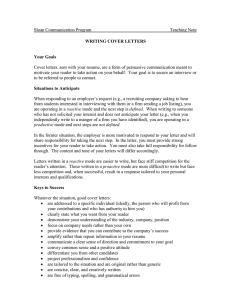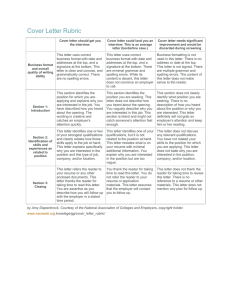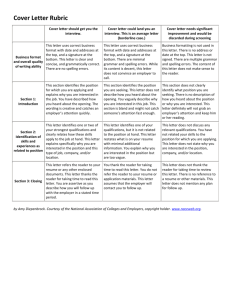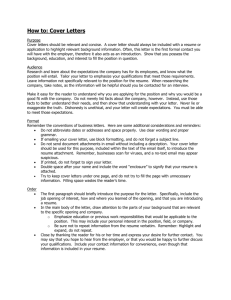Writing a Cover Letter Published May 19, 2014
advertisement
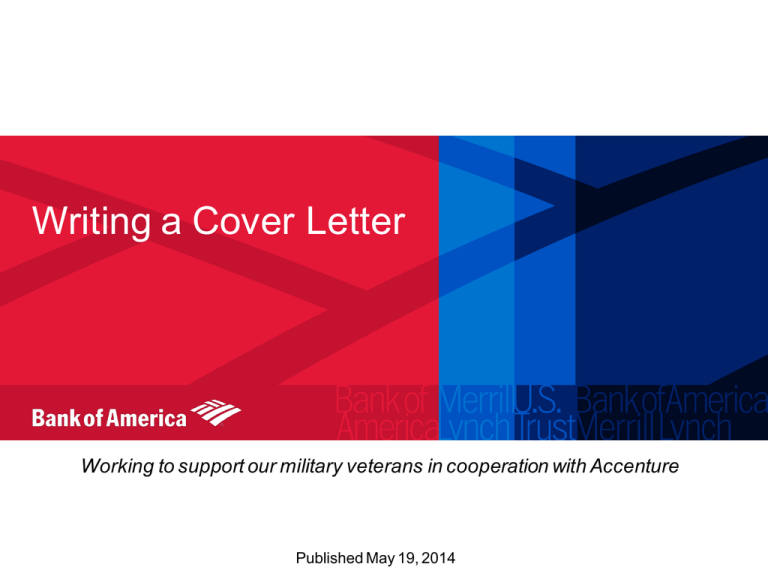
Writing a Cover Letter Working to support our military veterans in cooperation with Accenture Published May 19, 2014 Cover letter overview A cover letter goes along with your resume to tell the employer who you are and why you are interested in the job. When writing a cover letter, you should: • Convey your understanding of the employer and the job for which you are applying. • Be addressed to a specific contact or recruiter. • Showcase your background, knowledge and applicable skills. • Be specifically tailored for each job. • Present a clear, concise and powerful message. Before writing your cover letter, consider the following: • How does your background fit the job to which you are applying? • What points from your resume are especially noteworthy or relevant to the job? • Are you willing to, or interested in, relocation? • Do you have a reference within the company? • How can you show the company you have done your research? 2 Guidelines for writing your cover letter When writing your cover letter, you should remember the following key points: • If applicable, include job number / position code when applying to a specific job posting. • Indicate where you found the job description — for example, the web, friend or referral. • Open with why you are writing the cover letter. • Use active voice and verb tense. • Mention the name of the company. • Include your contact information. • Ensure that your cover letter is not longer than one page and is in standard businessletter format. • Include a different cover letter with every resume, unless an employer specifically asks for only a resume. 3 Cover letter opening The opening of your cover letter should grab the reader’s interest and make them want to read the letter and your resume. Features of a cover letter opening are: • Contact information — your name and contact information should appear at the top of the letter and be formatted to stand out from the rest of the letter. • Business letter format — this document should be written as a letter, including the date, subject line and addressed to the contact’s name. If you do not know who will receive the letter, it is ok to address the letter “To Whom It May Concern.” • Thanking the reader — thank the reader for his or her time and consideration. • Introduction of your goals — the reader should know why you are writing within the first two lines of your opening paragraph. 4 Cover letter body The body of your cover letter contains the majority of the important information about your skills and how you are a fit for the position. Features of a cover letter body are: • Why you're a good fit — consider what goals you and the company share, and explain to the reader how you could satisfy the company’s need. • What sets you apart — you are most likely not the only applicant for the job you seek, so be sure to highlight what sets you apart from the competition. • What applicable skills do you have — present your skills in such a way that they relate to the job you are seeking. Be sure to include any technical or language skills, as these are highly sought after across industry groups. Cover letter closing Your cover letter should close with a clear request to the reader or provide a statement of action from your part. Features of a cover letter body are: • Expressing interest — mention again to the reader the role you are pursuing in the company and how you fit the company's needs. Remember to not come on too strong. • Thanking the reader — thank the reader again for his or her time and for considering you as a potential candidate. • Looking forward to hearing back — your last line should indicate that you are looking forward to hearing next steps. Confidence is important here, as you want to sound self-assured, without coming off as arrogant. Final tips Your cover letter is your first impression to hiring managers and recruiters. Remember the following important points when writing your cover letter: • Include the job number and position code in the opening statement, if applicable. • Specify how you found the job. If you were referred by a current or former employee, who is in good standing, include that person’s name and position. • State your purpose and thank the reader for his or her time. • Use active voice and verb tense. • Relate to the company throughout your letter. Include any shared core values, how your skills match their need and what sets you apart from the competition. • Include information on how the employer can contact you. • Keep your cover letter to one page and in standard business-letter format. • Include a different cover letter with every resume, unless the employer specifically asks for only a resume. 7

